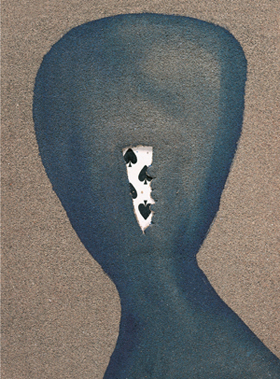
The Council on Middle East Studies (CMES), part of the Whitney and Betty MacMillan Center for International and Area Studies at Yale, is proud to be the fall 2009 host of “Breaking the Veils: Women Artists from the Islamic World,” an international exhibition designed to challenge stereotypes and enrich cross-cultural dialogue on women, the arts, and identity in the contemporary Arab and Islamic world. A selection of modern and contemporary works by 51 well-established female artists from 21 Arab and Islamic countries, the collection covers a range of media – from oils, acrylics, and watercolors to silk screens, etchings, collages, sculpture and treated photographic prints. The exhibition symbolizes Yale’s commitment to building strong relationships in the Middle East, and has served as a focal point for a wide range of related programming, both on Yale campus and in the local community.
“It’s not the physical but the ideological veils of misunderstanding that are at issue.”
In late September, Her Majesty Queen Rania Al-Abdullah of Jordan visited Yale campus and viewed the exhibit, whose world tour she helped to sponsor and inaugurate in 2002. Yale President Richard Levin called the Queen “a passionate force for cross-cultural dialogue.” He continued, “This exhibition has traveled throughout the Muslim world and has toured in Europe and the United States, and I am very proud to say it is currently on exhibit right here at Yale, at the Institute of Sacred Music.”
In line with Queen Rania’s special desire to reach young people, CMES is using the exhibit as an opportunity for educational and community outreach. As Jasmine Melvin-Koushki, Curator of the exhibit at Yale, notes, “The idea is to harness the power of original works of art to address pervasive stereotypes that exist in the way that Americans, especially young Americans, picture the Muslim world. Above all, I see my role as one of generating curiosity about the ways in which life on the ground there is different from what we’re shown on T.V.” So when Melvin-Koushki was approached by Deborah Elkin, a Connecticut middle school teacher, and invited to speak to her students at the Edgewood School in Westville and host a student tour of the exhibition, the two women quickly knew they were on the same page. According to Elkin, “When I read about the ‘Breaking the Veils’ exhibit, I wanted the 7th and 8th grade students in my geography class to learn about the diversity of the Muslim world through art – to go outside the classroom and reach different parts of the brain. Edgewood School has been an arts magnet school, so the concept of pairing traditional academic study with art made a lot of sense. Yet I wanted the students to have some background on the history of Islamic culture and its varied presence within different parts of the world before seeing the exhibit. Jasmine came to the class and engaged the students in an excellent introduction to the region that I’m confident will allow them to take much more away from their experience of the exhibit.”
In addition to engaging the Greater New Haven community, “Breaking the Veils” also served as the inspiration or centerpiece for events on Yale campus. Melvin-Koushki collaborated with Yale faculty to bring undergraduate students into the exhibit. On November 4, for example, students in Professr Geetanjali Chanda’s course, “Gender, Family, and Cultural Identity in Asia and the United States: A Dialogue,” were treated to an annotated walk-through of the exhibition. In collaboration with the Yale World Fellows Program, CMES hosted a talk by Saleh Barakat, renowned Beirut art dealer, gallerist, and World Fellow ’06, entitled, “Un/Veil: On Representations of the Veil in Middle Eastern Contemporary Art.” As Melvin-Koushki explains, “While the ‘veils’ referred to in the title of the exhibition are, of course, metaphorical – it’s not the physical but the ideological veils of misunderstanding that are at issue – Saleh and I thought it would be useful to address the evolution of the veil in Middle Eastern art in a very literal way, simply because, especially after 9/11, Arab and Iranian artists have been using the veil in their work in incredibly dynamic and creative ways.”
